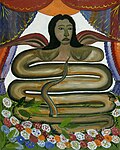Loa
Loa are the spirits of Voodoo. They are also referred to as "mystères" and "the invisibles" and are intermediaries between Bondye (from French Bon Dieu, meaning "good God") and humanity.[1] They have their own personal likes and dislikes, songs, dances, ritual symbols (Veve), and special modes of service.[1]
The word Loa (lwa) comes from Yoruba olúwa (meaning "lord" or "God").[2]
There are many families of loa: Rada (also Radha), Petro (also Pethro, Petwo), Agwé, Nago, Kongo and Ghede (also Guede, or Gede) among others. In a ritual the loa are called down by the houngan (priest) or mambo (priestess) to take part in the service, receive offerings, and grant requests.
Loa Media
A painting of the lwa Damballa, a serpent, by Haitian artist Hector Hyppolite.
The veve of the lwa Baron Samedi
A cross in the cemetery at Port-au-Prince, Haiti; this symbolizes the lwa Baron Samedi.[3]
A large sequined Vodou "drapo" or flag by the artist George Valris, depicting the veve of the lwa Loko Atison.
A drummer in a Vodou ceremony in Brooklyn, New York City during the early 1980s
A Vodou ceremony taking place in an ounfò in Jacmel, Haiti
References
- ↑ 1.0 1.1 Anthony B. Pinn. "The African American Religious Experience in America" Greenwood Press, 2005.
- ↑ Ramsey, Kate (2014). The Spirits and the Law: Vodou and Power in Haiti. University of Chicago Press. p. 19. ISBN 9780226703817.
- ↑ Brown 1991, pp. 368-369.






